27 Nonharmonic Tones
John Peterson
Key Takeaways
- Nonharmonic tones can be grouped into three categories:
- Involving only stepwise motion: passing tone, neighbor tone
- Involving a leap: appoggiatura, escape tone
- Involving static notes: suspension, retardation, pedal, anticipation
Overview
One of the tools that composers use to make music more interesting is the nonharmonic tone. Nonharmonic tones are pitches that are added to a composition that are not part of the surrounding chord. The nonharmonic tone creates dissonance which in turn creates momentary musical tension – a really cool effect. In this chapter you will learn about the various different kinds of nonharmonic tones and how they work, and learn how to identify them within a musical context.
How to Spot a Nonharmonic Tone
One of the most important skills to develop when working with nonharmonic tones is learning how to identify them. Once you have located a nonharmonic tone, it becomes much easier to determine its type, as the possibilities are fairly limited. The tutorial embedded below, “Desperately Seeking Nonharmonic Tones,” gives you an opportunity to practice finding nonharmonic tones in a musical selection with simple harmony.
Types of Nonharmonic Tones
In this next section we will explore the various types of nonharmonic tones, sometimes called “embellishing tones” or “non-chord tones”. These terms all mean the same thing.
Passing tones, neighbor tones: Nonharmonic tones that move by step
Example 1 showed the two kinds of embellishing tones that move by step: passing tones (PTs) and neighbor tones (NTs). Passing tones are approached by step and left by step in the same direction, either ascending or descending (Example 1). Neighbor tones are approached by step and left by step in the opposite direction, producing either an upper neighbor or a lower neighbor (Example 2).
Passing tones by openmusictheory
Example 1. Passing tones in a two-voice texture, (a) ascending and (b) descending.
Neighbor Tones by openmusictheory
Example 2. (a) Upper neighbor and (b) lower neighbor tones in a two-voice texture.
Double Neighbor Tones or Changing Tones
Double neighbor tones (DNT) (sometimes called “neighbor group” or changing tones (CT)) are made of two nonharmonic tones in a row. The first moves by step away from a chord tone, then skips to another nonharmonic tone, then moves by step to another chord tone, frequently the same chord tone.
Appoggiaturas and escape tones: Nonharmonic tones that involve a skip or leap
Appoggiaturas (APPs) and escape tones (ETs) involve either a skip or a leap. Appoggiaturas are approached by skip or leap and left by step in the opposite direction (Example 3). The appoggiatura typically occurs on a stronger part of the beat than its surrounding notes. Escape tones are approached by step and left by skip or leap in the opposite direction (Example 4). The escape tone typically occurs on a weaker part of the beat than its surrounding notes. It is more common for appoggiaturas and escape tones to be left by motion downward (Examples 3a and 4a) than upward (3b and 4b).
Appoggiatura by openmusictheory
Example 3. Appoggiaturas in a two-voice texture.
Escape Tones by openmusictheory
Example 4. Escape tones in a two-voice texture.
Examples 5 and 6 show the two kinds of embellishing tones that involve a leap: appoggiaturas and escape tones.
Joseph Boulogne, String Quartet No. 4, I, mm. 5-9 by openmusictheory
Example 5. An appoggiatura in Joseph Boulogne, String Quartet no. 4, I, mm. 5–9 (0:09-0:19).
ETs in Casson The Cuckoo by openmusictheory
Example 6. An escape tone in Margaret Casson, “The Cuckoo.”
Suspensions, retardations, anticipations, and pedal tones: Nonharmonic tones involving static notes
There are four kinds of embellishing tones that involve static notes (i.e., notes that don’t move): suspensions (SUS), retardations (RET), pedal tones (PED) and anticipations (ANT)
Suspensions and Retardations
Suspensions are approached by a static note and left by step down, while retardations are approached by a static note and left by step up. They follow a similar pattern:
Preparation–>Suspension (or retardation)–>Resolution
Suspensions are indicated in Roman numeral analysis not only by their abbreviations, but by the simplified intervals of the suspension and the resolution above the bass note. Retardations do not need to be labeled with the intervals above the bass note.
- 9-8. 7-6 and 4-3 suspensions are above the bass voice.
- 2-3 suspensions are in the bass voice.
- Both suspensions and retardations are always on a stronger part of the beat than the surrounding notes.
Why are all suspensions in the bass voice called 2-3 suspensions?
There is a pattern to the numbers used when the suspension is in an upper voice – the second number is always one less than the first number – 9-8, 7-6, 4-3. This is because the intervallic relationship between the upper notes and the bass voice gets smaller as the suspension resolves down by step (and closer to the bass). However, when the suspension is in the bass, the suspended note must still move down, making the resolution note farther away from all of the upper voices. This means the suspended note is closer to the upper notes, and the resolution is farther away, meaning that the intervallic relationship gets bigger. We use the numbers 2-3 because there will always be a 2-3 relationship between the suspension and resolution in the bass and one of the upper voices.
The fourth suspension in Example 7 demonstrates a 2-3 suspension. In this case the 2-3 relationship is between the bass and the “A” in the soprano voice.
Example 7 below illustrates how the melodic pattern of Preparation–>Suspension–>Resolution works, and the intervallic relationships of the various suspensions and resolutions to the bass voice.
Example 7. 9-8, 7-6, 4-3 and 2-3 suspensions.
Example 8 provides a few examples of retardations.
Example 8. Retardations by empauly
Pedal Tones
Pedal tones are often found in the bass. They consist of a series of static notes below chord changes that do not include the bass. We typically label them using the scale degree number of the pedal note, as in Example 9.
Example 9: Josephine Lang, Dem Konigs-Sohn, mm. 16-18 by openmusictheory
Anticipations
Like the suspension, retardation, and pedal tone, anticipations also involve static notes. But anticipations are a two-note (rather than three-note) gesture, in which a chord tone is heard early as a non-chord tone (Example 10). In other words, it “anticipates” its upcoming membership in a chord.
Embellishing_Tones_ by openmusictheory
Example 10. An anticipation in Josephine Lang’s “Erinnerung,” mm. 29–30 (1:54–1:59).
Quick Review
This tutorial by MusicTheory.Net provides a quick review/overview of nonharmonic tones. You may wish to review it now, or reference it later. If the audio does not play, please switch to a different browser.
Exercise provided by musictheory.net
Summary
The table in Example 11 provides a summary of the embellishing tones covered in this chapter.
| Embellishing Tone | Approached by | Left by | Direction | Additional Detail | Example |
|---|---|---|---|---|---|
| Passing Tone (PT) | Step | Step | Same | May ascend or descend | 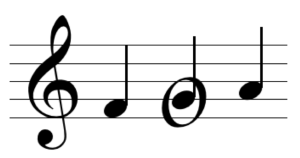 |
| Neighbor Tone (NT) | Step | Step | Opposite | Both upper and lower exist | 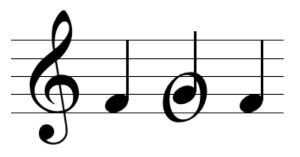 |
| Double Neighbor or Changing Tone (CT) | Step then Skip | Step | Varies | Chord tone to nonchord tone, to nonchord tone to chord tone |  |
| Appoggiatura (APP) | Leap | Step | Opposite | Appoggiatura is usually on a strong part of the beat |  |
| Escape Tone (ET) | Step | Leap | Opposite | Escape tone is usually on a weaker part of the beat | 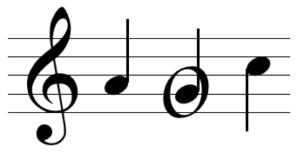 |
| Suspension (SUS) | Static note | Step | Down | Suspension is always on a stronger part of the beat | 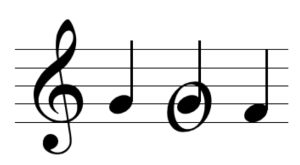 |
| Retardation (RET) | Static note | Step | Up | Retardation is always on a stronger part of the beat | 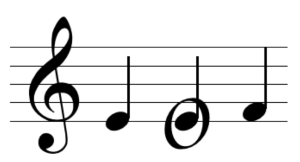 |
| Pedal Tone (PED) | Static note | Static note | N/A | Stays on the same pitch | 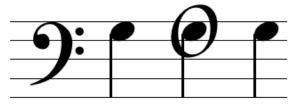 |
| Anticipation (ANT) | N/A | Static note | N/A | The anticipation is usually on a weaker part of the beat | 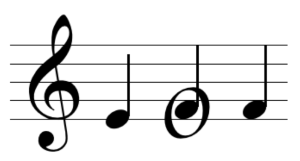 |
Example 11. Summary of embellishing tones.
- Embellishing tones (.pdf, .mscz). Asks students to write embellishing tones in a two-voice texture and label embellishing tones in an excerpt. Worksheet recording
References
This chapter is an adaptation of “Embellishing Tones” by John Peterson in Open Music Theory, vs. 2. Adaptations include:
- Adding a section on double neighbor tones.
- Adding the H5P activity “Desperately Seeking Nonharmonic Tones”
- Adding additional information on suspensions and retardations, including the section “Why are all the suspensions in the bass voice called 2-3 suspensions?”
- Amending the table summary of nonharmonic tones at the end of this chapter to include images of nonharmonic tones, which come from Victoria Malawey’s chapter “Non-Chord Tones” from Multimodal Musicianship.
- Embedding the Nonharmonic Tones lesson from MusicTheory.net.
All materials used in this chapter are licensed with the Creative Commons CC BY-NC-SA 4.0 International license.
Resources
In addition to the sources cited above, the following resources were consulted in the adaptation of this chapter:
Benward, Bruce and Saker, Marilyn. (2021). Cadences and Nonharmonic Tones. Music in Theory and Practice, vol. 1.
Hutchinson, Robert. (2025). Non-Chord Tones. Music for the 21st Century Classroom.
Mount, A. (n.d.) Nonharmonic Tones. Fundamentals, Function and Form. University of Nebraska. Pressbooks.
A type of motion where a chord tone moves by step to another tone, then resolves by step in the same direction. For example, C–D–E above a C major chord would be an example of neighboring motion, in which D can be described as a passing tone. Entire harmonies may be said to be passing when embellishing another harmony, when the voice-leading between the two chords involves mainly passing tones (as in the passing 6/4 chord).
Nonharmonic tones that are approached by step and left by step in the opposite direction.
A nonharmonic tone often occurring on a strong beat that is approached by leap and left by step in the opposite direction.
A nonharmonic tone that is approached by step and left by leap in the opposite direction.
A nonharmonic tone that is approached via static note and left by step down. The suspension is on a strong part of the beat.
A nonharmonic tone that is approached by static note and left by step up. The retardation is on a stronger part of the beat.
Pedal tones are often found in the bass. They consist of a series of static notes over top of which chord changes occur that do not include the bass.
A two-note nonharmonic tone gesture in which a chord tone is heard early as a non-chord tone.
Notes that decorate other, more structurally important notes. Embellishing tones are often not part of the prevailing chord. Types of embellishing tones include passing tones, neighbor tones, appoggiaturas, escape tones, pedal tones, suspensions, and anticipations.
A perceived quality of auditory roughness in an interval or chord.
Melodic movement by third.
a leap is an interval greater than a third.
notes that don't move
